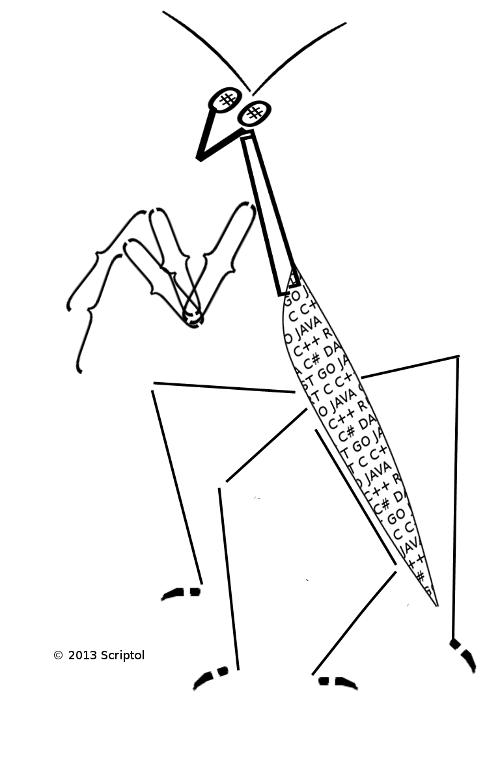Beyond cabalistic programming languages...
Am I the only one who thinks these hooks and other cabalistic symbols are pretty aggressive?
A program written in C, or even worse in C++, or by one of his descendants, often makes me think of these bugs, mess with hooks and other stinging... Like, for example, a religious praying mantis.

If you judge by some comments on programming languages received from C, the answer is that I am not the only one...
A few quotes...
"When your hammer is C++, every single thing starts to gather at your thumb."
"Program C is like a quick dance on a freshly-lit dance floor by people holding razors."
"C++ has a place in the history of programming languages. Like Caligula in the history of the Roman Empire ."
"Moving from Pascal programming to C programming is like learning to write in Morse code."
"Writing in C or C++ is like using a chainsaw with all the protections removed."
"Perl is the only language that sounds the same before and after RSA encryption."
These hooks and hugs made sense for the creators of C. Compared to the words begin end, for example, they reduced the parsing time of the program and with computers in 1972 this was a noticeable advantage, but these days it is ten thousand times more powerful with machines!
When in semicolons, creator C retrospectively thought it was a design error. By the way, they are optional in JavaScript.
JavaScript, like many other languages, also drew inspiration from C syntax, but since it is an interpreted language, and in the browser, which moreover, it needs this amber syntax. On the other hand, it was far from the need for Java or Go...
As I showed in another article, programming language is an area that designers say doesn't deserve to consider the comfort of the user - in this case, the programmer - and especially the novice. This is an area where you need to stick to habits. Whose? Not beginners, obviously, these are rather the habits of the creator of the language in fact. But not only.
I don't know if this was the subject of careful study by psychologists, it was described in any case by Jean-Paul Sartre, the more the user suffers, when something is instilled in him, the more he will be attached to it and the more he will object, After he has mastered the subject, we can change the situation. This is probably why these brackets, hugs and other sharp symbols that hurt in the eyes are just as firmly held in the habits of programmers .
Among the languages that have tried a new and better inspired approach to my opinion is, of course, Scriptol, more recently there is Quorum, and these two languages have become popular, Python and Ruby. However, the latter are undermined. First in Go, another language broken by brackets and even worse than C, but with the advantage of compilation speed. Second to Scala or JavaScript with Node, both are more "scalable ."
The increasing use of JavaScript, in spite of everything, is not bad, because it is an inventive language in its design, despite the flaws in the details .
On the other hand, there are several languages that are easier to understand and compile in JavaScript. Perhaps this is the future of programming. Not only in cosmetic languages made for the convenience of writing programs while maintaining a portable backend, but also in very high-level languages that are compiled into those classic languages that are recognized on all platforms. Languages with interactivity for debugging, allowing you to self-correct errors, study programs .
Then we can avoid all these hooks that seem to want to pin you down for the rest of time.